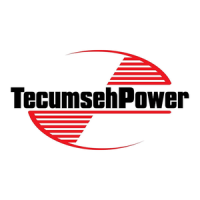
Do you have a question about the Tecumseh H30 and is the answer not in the manual?
| Fuel Type | Gasoline |
|---|---|
| Compression Ratio | 6.5:1 |
| Lubrication | Splash |
| Ignition System | Magneto |
| Starting System | Recoil |
| Governor Type | Mechanical |
| Horsepower | 3 HP |
| Oil Capacity | 0.63 qt (0.6 L) |
| Fuel Tank Capacity | 1.5 qt (1.4 L) |
| Spark Plug | Champion J8C |
Explains carbon monoxide risks and prevention steps for engine operation.
Provides instructions to prevent injury or death from gasoline fires during refueling and storage.
Emphasizes adult responsibility for safe operation, refueling, and maintenance of the engine.
Warns about entanglement risks with moving engine parts and the necessity of proper guards.
Critical warning against modifying engine governor settings or components.
Highlights risks from hot engine parts and fire hazards, advising precautions.
Provides crucial steps to prevent accidental engine startup during maintenance.
Recommends wearing hearing protection due to potential hearing damage from engine noise.
Details how to contact authorized dealers for adjustments, repairs, or warranty service.
Explains the importance of the engine identification decal for referencing specifications and emissions data.
Information on obtaining technical handbooks for advanced engine repair and service.
Details the type of oil required and oil sump capacity for engine operation.
Specifies acceptable types of unleaded gasoline and prohibited fuel additives for the engine.
Guides on how to check engine oil level using the dipstick to prevent damage.
Step-by-step instructions for adding oil using a dipstick oil fill cap.
Instructions for adding oil to the engine using an oil fill plug.
Explains the function and operation of the engine stop switch for shutting down the engine.
Crucial safety warnings and procedures for refueling the engine to prevent fires.
Important safety warnings and instructions before attempting to start the engine.
Step-by-step guide for starting engines equipped with a primer bulb and electric starter.
Procedure for starting engines using a choke and electric starter.
Instructions for starting engines with a primer bulb and recoil starter.
Safe procedure for pulling the starter rope to prevent injury from recoil.
Guidance on how to restart the engine if it falters or dies after initial start using the choke.
Safety precautions for stopping the engine and storing it for short periods.
General safety guidelines and preparation steps before performing engine maintenance.
Detailed steps for draining old oil and refilling with new oil, including safety.
Identifies key areas on the engine where debris should be removed for proper cooling and function.
Procedure for checking, gapping, and replacing the spark plug for optimal performance.
Guidance on identifying and servicing different types of air cleaners (Type A & B).
Instructions for cleaning foam pre-filters, emphasizing not to oil them.
Procedure for replacing paper air filters, noting they cannot be cleaned.
Information regarding carburetor adjustment and altitude performance.
Critical warnings against modifying the governor setting to prevent unsafe speeds.
Essential safety rules for transporting the engine, especially regarding fuel.
Steps for cleaning and preparing the engine for short-term storage to prevent damage.
Advice on safe fuel storage practices to avoid explosions and engine issues.
Procedure for adding fuel stabilizer to prevent fuel degradation during storage.
Instructions on how to safely drain fuel and lubricate the cylinder for extended storage.
Information on local laws requiring spark arresters and how to maintain them.
Table outlining recommended maintenance procedures and their intervals for engine longevity.
Details the warranty coverage for emission control systems on new engines.
Outlines the owner's duties regarding maintenance and care for warranty validity.
Defines the scope and duration of the Emission Control System Warranty.
Explains what the warranty covers regarding engine conformity and defects.
Lists components that are covered under the Emission Control System Warranty.
Outlines the terms and conditions of the limited warranty for engines and ignition modules.
Distinguishes warranty coverage based on whether use is consumer or commercial.
